Eupatoriums are the ‘Hemp Agrimony’ family, named after the ancient Persian Emperor Mythridates Eupator who believed in its medicinal properties and had it planted around his palaces. Many Eupatoriums native to North America and used in gardens have recently been reclassified as Eutrochium, native to Central and South America as Ageratina and the Eurasian natives stay as Eupatorium. Also known as ‘Joe Pye Weed’ after an Algonquin Indian who used it to cure Typhus. The new DNA research into these plants is still continuing. They are all very attractive to butterflies and bees while adding great colour to the autumn herbaceous border.
We are not normally open to the public, but you can make an appointment to visit to see the collection when it is in flower from late August to October, email Jan@7wells.org to arrange a visit.
BBC Gardeners World featured the collection in 2013.
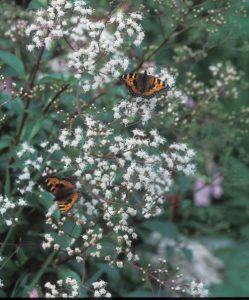
Ageratina ligustrina
Previously Eupatorium ligustrinum now (Ageratina ligustrina) Lovely shrubby, compact, scented plant. Grow it in a pot on the patio and the butterflies will come to you! If brought into the conservatory in winter it will continue to flower for many months. Can also be grown outside in many mild regions, but may be cut down by frost in hard winters.
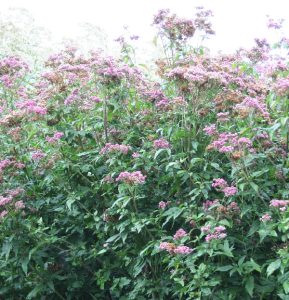
Eupatorium cannabinum – ‘Flore Plano’
The double-flowered form of the native Hemp Agrimony. This is a good filler plant for big spaces – eg. prairie planting schemes. In the small garden border it can be a bit invasive. The flowers are not so attractive to butterflies, but they last longer than the single form.
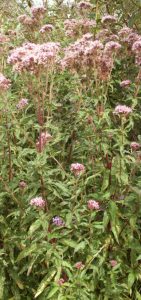
Eupatorium cannabinum – ‘Spraypaint’
This is very similar to the wild Hemp Agrimony, but with attractive splashes of yellow on the leaves.
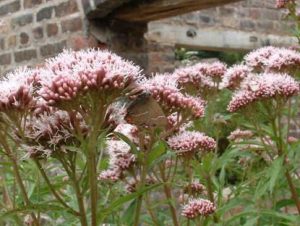
Eupatorium cannabinum – wild Hemp Agrimony
This is one of the very best late wildflowers for butterflies. It is the only Eupatorium native to Britain. This photo was taken in the Greenfield Valley by Brian Roberts who has spent many years monitoring the butterflies in this nature and history park; there is a rare White-letter Hairstreak feeding on it. The flowers also attract many moths at night. This plant likes to grow in damp conditions, where it can grow to 3 or
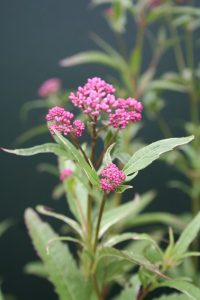
Eupatorium fortunei – ‘Fine Line’
This is one of the Asian species – smaller plant/height, much brighter pink flowers and delicate leaves with a fine white line around the edge.
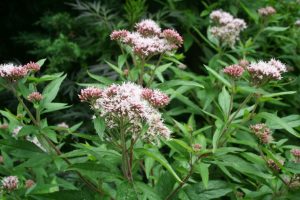
Eupatorium lindleyanum
One of the Asian species brought back by the plant hunter John Lindley in the 19th century. This forms a broad clump, but not as high as the pupureum group, and has fluffy pink flowers for longer than E.cannabinum.

Eutrochium dubium ‘Baby Joe’
The perfect size for smaller gardens, this is a lovely selection of Joe-Pye Weed, even smaller than ‘Little Joe’. It forms a bushy upright mound of coarse dark-green leaves, bearing large umbrella-like heads of magenta-pink flowers in late summer. A magnet to butterflies, suitable for planting in moist to wet areas. Ideal as a focal point in a large container or tub. Dried seedheads offer good winter interest and the flowers are good for cutting
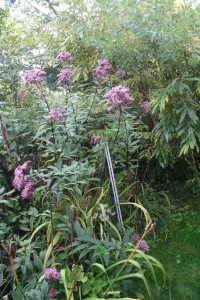
Eutrochium dubium ‘Little Joe’
A new dwarf form imported from Holland. The perfect size for smaller gardens, this is the first truly compact selection of Joe-Pye Weed. It forms a bushy and substantial upright mound of coarse dark-green leaves, bearing umbrella-like heads of rosy-purple flowers in late summer. A magnet to butterflies, suitable for planting in moist areas. Ideal as a focal point in a large container or tub. Dried seedheads offer good winter interest. Height 90-120 cm / 35-47 inches in
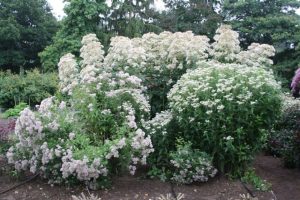
Eutrochium fistulosum ‘Bartered Bride’
One of the best white flowered varieties, the only white one of several that I have been able to get through the wet winters in my northern garden. It can reach same height and spread as the Atropurpureum group in a couple of years.In this photo it can be seen as the tallest flower at the rear of this trial bed at Wisley a few years ago.

Eutrochium pupureum ‘Riesenschirm’
Very similar to Atropurpureum but perhaps slightly more robust with darker purple stems. Makes a big tall(6foot) deep purple clump in a couple of years. Seen in this photo on the right at the RHS trials at Wisley; on the left is E. puprpureum ‘Atropurpureum’
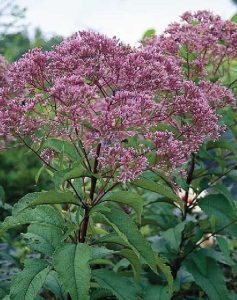
Eutrochium purpureum ‘Little Red’
Specially imported from USA by us, this deep red variety was sold to us as a shorter form than the ‘Atropurpureum’ more commonly seen in this country, however, after 3 or 4 years growing in good damp conditions it has reached the same six-foot heights as ‘Atropurpureum’ in our garden! It will, however, grow short (about 3 feet) in the first year or two. then need dividing to keep it compact. If you want REALLY dwarf varieties see our new ‘Little

Eutrochium purpureum maculatum ‘Atropurpureum’
This is one of the biggest and the purplest! Growing to over 5 feet tall it’s a wonderful plant for the back of the herbaceous border – great with grasses for autumn effect; often used in ‘prairie planting’ and Piet Oudolf designs. Clump-forming hardy perennial. Will tend to grow shorter in the first year of planting, and get bigger in subsequent years.